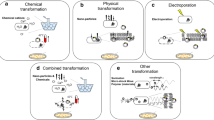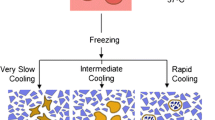Abstract
This study investigated whether molecules spontaneously transported inside cells, like glucose derivatives, can also be used as electropermeabilization markers. Uptake of a fluorescent deoxyglucose derivative (2-NBDG) by normal and electropermeabilized cells in culture was analyzed. 2-NBDG was added to DC-3F cell suspensions and cells, exposed or not to eight square-wave electric pulses of 100-μs duration and of appropriate field amplitude at a repetition frequency of 1 Hz or 5 kHz, were incubated at 37 °C. 2-NBDG uptake was temperature-, concentration- and time-dependent in cells submitted or not to the electric pulses. In spite of significant uptake of 2-NBDG mediated by GLUT transporters into nonpermeabilized cells, the electric pulses significantly increased about ten to hundred times the 2-NBDG uptake into the cells. The increase in the field amplitude from 900 to 1,500 V/cm resulted in a progressive increase of 2-NDBG. Our results show that under the conditions of in vivo exposure duration to FDG and the physiological concentration of d-glucose, electric pulses increased 2-NBDG uptake into electropermeabilized cells. Under our experimental conditions, the percentage of permeabilized cells within the population of cells exposed to electric pulses remained at the same level regardless of the pulse frequency used, 1 Hz or 5 kHz. The findings showed that glucose derivatives can also be used to detect electropermeabilized cells exposed to electric pulses.







Similar content being viewed by others
References
Aloj L, Caraco C, Jagoda E, Eckelman WC, Neumann RD (1999) Glut-1 and hexokinase expression: relationship with 2-fluoro-2-deoxy-d-glucose uptake in A431 and T47D cells in culture. Cancer Res 59:4709–4714
Biedler JL, Riehm H (1970) Cellular resistance to actinomycin D in Chinese hamster cells in vitro: cross-resistance, radioautographic, and cytogenetic studies. Cancer Res 30:1174–1184
Bomanji JB, Hyder SW, Gaze MN, Gacinovic S, Costa DC, Coulter C, Ell PJ (2001) Functional imaging as an aid to decision-making in metastatic paraganglioma. Br J Radiol 74:266–269
Breton M, Mir LM (2012) Microsecond and nanosecond electric pulses in cancer treatments. Bioelectromagnetics 33:106–133
Cemazar M, Sersa G, Miklavcic D (1998) Electrochemotherapy with cisplatin in the treatment of tumor cells resistant to cisplatin. Anticancer Res 18:4463–4466
Cemazar M, Miklavcic D, Mir LM, Belehradek J Jr, Bonnay M, Fourcault D, Sersa G (2001) Electrochemotherapy of tumors resistant to cisplatin: a study in a murine tumor model. Eur J Cancer 37:1166–1672
Chen CP, Li XX, Zhang LR, Min JM, Chan JY, Fung KP, Wang SQ, Zhang LH (2002) Synthesis of antisense oligonucleotide-peptide conjugate targeting to GLUT-1 in HepG-2 and MCF-7 cells. Bioconjug Chem 13:525–529
Cheng Z, Levi J, Xiong Z, Gheysens O, Keren S, Chen X, Gambhir SS (2006) Near-infrared fluorescent deoxyglucose analogue for tumor optical imaging in cell culture and living mice. Bioconjug Chem 17:662–669
Chin BB, Chang PP (2006) Gastrointestinal malignancies evaluated with 18F-fluoro-2-deoxyglucose positron emission tomography. Best Pract Res Clin Gastroenterol 20:3–21
Djuzenova CS, Zimmermann U, Frank H, Sukhorukov VL, Richter E, Fuhr G (1996) Effect of medium conductivity and composition on the uptake of propidium iodide into electropermeabilized myeloma cells. Biochim Biophys Acta 1284:143–152
Flier J, Mueckler M, Usher P, Lodish H (1987) Elevated levels of glucose transport and transporter messenger RNA are induced by ras and sarc oncogenes. Science 235:1492–1495
Gehl J, Skovsgaard T, Mir LM (1998) Enhancement of cytotoxicity by electropermeabilization: an improved method for screening drugs. Anticancer Drugs 9:319–325
Hoh CK, Hawkins RA, Glaspy JA, Dahlbom M, Tse NY, Hoffman EJ, Schiepers C, Choi Y, Rege S, Nitzsche E, Maddahi Y, Phelps ME (1993) Cancer detection with whole-body PET using 2-[18F] fluoro-2-deoxy-d-glucose. J Comput Assist Tomogr 17:582–589
Iori I, Satoshi W, Yutaka K (2006) Mapping of odor-related neuronal activity using a fluorescent derivative of glucose. Neurosci Lett 398:224–229
Itoh Y, Abe T, Takaoka R, Tanahashi N (2004) Fluorometric determination of glucose utilization in neurons in vitro and in vivo. J Cereb Blood Flow Metab 24:993–1003
Jaroszeski MJ, Dang V, Pottinger C, Hickey J, Gilbert R, Heller R (2000) Toxicity of anticancer agents mediated by electroporation in vitro. Anticancer Drugs 11:201–208
Kambe M, Arita D, Kikuohi H, Funato T, Tezuka F, Gamo M, Murakawa Y, Kanamaru R (1996) Enhancing the effect of anticancer drugs against the colorectal cancer cell line with electroporation. Tahoku J Exp Med 180:161–171
Kuriyama S, Matsumoto M, Mitoro A, Tsujinoue H, Nakatani T, Fukui H, Tsujii T (2000) Electrochemotherapy for colorectal cancer with commonly used chemotherapeutic agents in a mouse model. Dig Dis Sci 45:1568–1577
Lloyd PG, Hardin CD, Sturek M (1999) Examining glucose transport in single vascular smooth muscle cells with a fluorescent glucose analog. Physiol Res 48:401–410
Marty M, Sersa G, Garbay JR, Gehl J, Collins CG, Snoj M, Billard V, Geetsen PF, Larkin JO, Miklavcic D, Pavlovic I, Paulin-Kosir SM, Cemazar M, Morsli N, Soden DM, Rudolf Z, Robert C, O’Sullivan G, Mir LM (2006) Electrochemotherapy—an easy, highly effective and safe treatment of cutaneous and subcutaneous metastases: results of ESOPE (European standard operating procedures of electrochemotherapy) study. Eur J Cancer Suppl 4:3–13
Melvik JE, Pettersen EO, Gordon PB, Seglen PO (1986) Increase in cis-dichlorodiammineplatinum (II) cytotoxicity upon reversible electropermeabilization of the plasma membrane in cultured human NHIK 3025 cells. Eur J Cancer Clin Oncol 22:1523–1530
Mir LM (2001) Therapeutic perspectives of in vivo cell electropermeabilization. Bioelectrochemistry 53:1–10
Mir LM (2006) Bases and rationale of the electrochemotherapy. Eur J Cancer Suppl 4:38–44
Mir LM, Banoun H, Paoletti C (1988) Introduction of definite amounts of nonpermanent molecules into living cells after electropermeabilization: direct access to the cytosol. Exp Cell Res 175:15–25
Natarajan A, Srienc F (1999) Dynamics of glucose uptake by single Escherichia coli cells. Metab Eng 1:320–333
Neumann E, Schaeter-Ridder M, Wang Y, Hofshneider PH (1982) Gene transfer into mouse lyoma cells by electroporation in high electric fields. EMBO J 7:841–845
Nitin N, Carlson AL, Muldoon T, El-Naggar AK, Gillenwater A, Richards-Kortum R (2009) Molecular imaging of glucose uptake in oral neoplasia following topical application of fluorescently labeled deoxy-glucose. Int J Cancer 124:2634–2642
O’Neil RG, Wu L, Mullani N (2005) Uptake of a fluorescent deoxyglucose analog (2-NBDG) in tumor cells. Mol Imaging Biol 7:388–392
Oh KB, Matsuoka H (2002) Rapid viability assessment of yeast cells using vital staining with 2-NBDG, a fluorescent derivative of glucose. Int J Food Microbiol 76:47–53
Orlowski S, Belehradek J Jr, Paoletti C, Mir LM (1988) Transient electropermeabilization of cells in culture. Increase of the cytotoxicity of anticancer drugs. Biochem Pharmacol 37:4727–4733
Pauwels EKJ, Sturm EJC, Bombardieri E, Cleton V, Stokkel MPM (2000) Positron-emission tomography with [18F]fluorodeoxyglucose. Part I. Biochemical uptake mechanism and its implication for clinical studies. J Cancer Res Clin Oncol 126:549–559
Pron G, Mahrour N, Orlowski S, Tounekti O, Poddevin B, Belehradek Jr J, Mir LM (1999) Internalization of the bleomycin molecules responsible for bleomycin cytotoxicity: a receptor-mediated endocytosis mechanism. Biochem Pharmacol 57:45–56
Pucihar G, Mir LM, Miklavcic D (2002) The effect of pulse repetition frequency on the uptake into electropermeabilized cells in vitro with possible applications in electrochemotherapy. Bioelectrochemistry 57:167–172
Reske S, Kotzerke J (2001) FDG-PET for clinical use. Eur J Nucl Med 28:1707–1723
Sersa G, Cemazar M, Miklavcic D (1995) Antitumor effectiveness of electrochemotherapy with cis-diamminedichloroplatinum (II) in mice. Cancer Res 55:3450–3455
Sersa G, Cemazar M, Rudolf Z (2003) Electrochemotherapy: advantages and drawbacks in treatment of cancer patients. Cancer Ther 1:133–142
Silve A, Mir LM (2011) Cell electropermeabilization and cellular uptake of small molecules: the ECT concept. In: Kee ST, Gehl J, Lee EW (eds) Clinical aspects of electroporation. Springer, New York, pp 69–82
Yamada K, Nakata V, Horimoto N, Saito M, Matsuoka H, Inagaki N (2000) Measurement of glucose uptake and intracellular calcium concentration in single, living pancreatic b-cells. J Biol Chem 275:22278–22283
Yoshioka K, Takahashi H, Omma T, Sato M, Ki Bong O, Nemoto Y, Matsuoka HK (1996a) A novel fluorescent derivative of glucose applicable to the assessment of glucose uptake activity of Escherichia coli. Biochim Biophys Acta 1289:5–9
Yoshioka K, Saito M, Oh KB, Nemoto Y, Matsuoka H, Natsume M, Abe H (1996b) Intracellular fate of 2-NBDG, a fluorescent probe for glucose uptake activity in Escherichia coli cells. Biosci Biotech Biochem 60:1899–1901
Yoshioka K, Oh KB, Saito M, Nemoto Y, Matsuoka V (1996c) Evaluation of 2-[N-(7-nitrobenz-2-oxa-1,3-diazol-4-yl)amino]-2-deoxy-d-glucose, a new fluorescent derivative of glucose, for viability assessment of yeast Candida albicans. Appl Microbiol Biotechnol 46:400–404
Younes M, Lechago LV, Somoana JR, Mosharaf M, Leechago J (1996) Wide expression of the human erythrocyte glucose transporter GLUT1 in human cancers. Cancer Res 56:1164–1167
Zhang Z, Li H, Liu Q, Zhou L, Zhang M, Luo Q, Glickson J, Chance B, Zheng G (2004) Metabolic imaging of tumors using intrinsic and extrinsic fluorescent markers. Biosens Bioelectron 20:643–650
Zou C, Wang Y, Shen Z (2005) 2-NBDG as a fluorescent indicator for direct glucose uptake measurement. J Biochem Biophys Methods 64:207–215
Acknowledgements
This research was conducted in the scope of the European Associated Laboratory “Electroporation in Medicine and Biology” (LEA EBAM). E. R. thanks the staff of the Laboratoire de Vectorologie et Thérapeutiques Anticancéreuses, UMR 8203 CNRS Université Paris-Sud, Institute Gustave-Roussy, Villejuif, France, for their hospitality during this research and the Biomedical Center of the European Scientific Institute, Archamps, France, for partial financial support. E. R. also thanks Dr. Malihe Nasiri, Biostatistics Department, Tarbiat Modares University, Tehran, Iran, for helping with the statistical tests.
Author information
Authors and Affiliations
Corresponding author
Rights and permissions
About this article
Cite this article
Raeisi, E., Mir, L.M. 2-NBDG, a Fluorescent Analogue of Glucose, as a Marker for Detecting Cell Electropermeabilization In Vitro. J Membrane Biol 245, 633–642 (2012). https://doi.org/10.1007/s00232-012-9479-6
Received:
Accepted:
Published:
Issue Date:
DOI: https://doi.org/10.1007/s00232-012-9479-6




